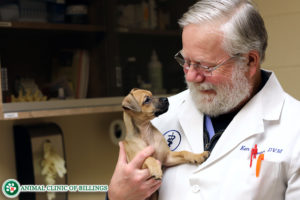Dog Elbow Surgery
elbow forelimb osteochondritis dissecans (OCD) surgery – Stage 1
The underwater treadmill is one of the most valuable pieces of equipment in aquatic therapy. Hydrotherapy can result in significant gains in strength, ROM, function, and overall cardiovascular fitness. Please schedule Name hydrotherapy sessions 2 or 3 times weekly for the next 4-8 weeks.
Goals:
- Reduce lameness and inflammation
- Improve the use of the surgery limb
- Continue to control pain
- Increase weight bearing at stand
- Begin returning the limb to full function
Treatments:
Rest is important. While healing, it is important to keep your pet confined when you are not able to be with him/her. This will help to prevent over use and other complications.
Bandage care:
Change every 4-10 days Laser during bandage changes. Keep your dogs bandage clean, dry, and protected. Remove the bandage cover when inside. Perform gentle ROM during bandage changes.
Medication:
Administer the entire course of Clavamox (62.5mg 1 tab Bid for 7 days) Continue with Rimadyl and Tramadol for a minnium of 2 weeks, then as needed.
Once your pet has his/her bandage permanently off do the following twice daily:
Superficial ice/heat
- Use an ice pack for the first few days after surgery to reduce swelling and inflammation. Switch to heat once swelling is reduced to increase circulation, decrease pain, and improve extensibility.
- Place a rolled towel underneath the surgery limb this will help keep the leg parallel to the floor and decrease stress on any joints.
- Lay Name down with the surgery limb up. Place another towel on the limb at the surgery site. Apply ice/heat using the gel pack. Heat can also be provided using moist warm towels, a warm bath, or shower massage
- Allow the cool/warmth to penetrate the tissue, which usually takes about 15-20 minutes.
Massage
Starting at the toes using gentle sweeping motion, massage the limb going all the way from the toes up to the chest/shoulder area. Light pressure during massage will stimulate circulation, which in turn will help to decrease inflammation.
Passive Range of Motion Exercises
- Bicycle the limb through its full range of motion. Do 10 repetitions of the limb. This exercise should be done lying and standing.
- Gently apply pressure to the toes of the front paw to get Name to retract the limb away from you. Hold the limb and resist for 5 seconds. Then release. Do this 5 times.
*These exercises should not cause pain. Only take the joint to a comfortable flexion or extension.
ADD THESE EXERCISES AT DAY 4 POST-OP
- Short leash walks on flat surface is recommended. We want movement, but we want it controlled. Go very slow to encourage weight bearing.
- Warm packs, massage, and range of motion proves to be the most beneficial. After these exercises TWO leash walks a day would also help with recovery.
- Shake hands exercise (If there is a bandage, begin once it’s removed)
This exercise actively flexes the elbow joint and conditions the muscles of the front legs. Stand in front of Name and ask him/her to sit and encouraging to “shake hands.” Using treats may be helpful for this exercise. Repeat for 5 to 10 repetitions, several times daily.
Ice – Post Exercise
Apply a towel over the limb and place an ice pack over the surgery site for 10-15 minutes.
* Activity at this stage should be closely monitored and kept at a minimum.
If you have any questions, concerns, or your dog has a decrease in limb use, please call us.
406-252-9499
Stage 2
The underwater treadmill is one of the most valuable pieces of equipment in aquatic therapy. Hydrotherapy can result in significant gains in strength, ROM, function, and overall cardiovascular fitness. Please schedule your dog for hydrotherapy sessions 2 or 3 times weekly for the next 4-8 weeks.
Gradual return to regular activity is important included in this hand out are exercises to help.
- Sit to stand & down to stand exercises – To strengthen the fore limb muscles, your dog may start doing sit to stand exercises. Walk your dog along a wall or fence line with the surgery limb on the side of the wall/fence. Ask him or her to sit then stand. Repeat 10 times 3 times daily. Once sit to stands are going well transition to down to stand. The purpose of having the limb against the wall is to have a brace they can push against as they rise.
- Your dog can start doing 10 minutes of trotting every other day at a moderate speed. Increase to 15 minutes in 2 weeks. Then monitored of leash for 1 month. Avoid sharp turns and jumping down.
- Walk your dog in a figure 8 pattern or in circles to the left then the right to encourage weight bearing on the surgery limb.
- High Five, Shake Hands, or Waving! Any of these activities will help to build muscle and increase your dog’s flexibility.
- Plan to return in 1 month for x-rays and exam. At that time we are hoping to be free of restrictions!
If you have any questions or concerns please call us. In addition if any increase in lameness is noted and last longer than 24 hours please have your dog seen by a Veterinarian.
406-252-9499

Let our highly trained and experienced team of veterinarians and veterinary technicians help you keep your cat as happy and healthy as they can be.
Call the Animal Clinic of Billings and Animal Surgery Clinic to schedule your pet cat’s next wellness examination with one of our veterinarians today!
406-252-9499 REQUEST AN APPOINTMENT
ANIMAL CLINIC OF BILLINGS AND ANIMAL SURGERY CLINIC
providing our region’s companion animals and their families what they need and deserve since 1981
1414 10th St. West, Billings MT 59102
406-252-9499



